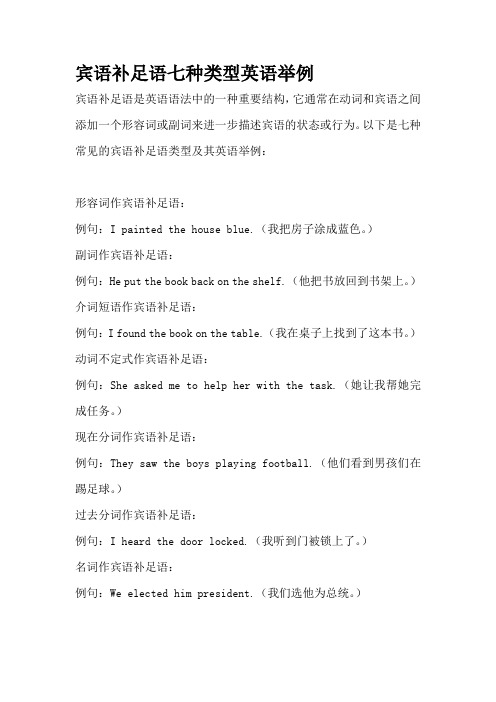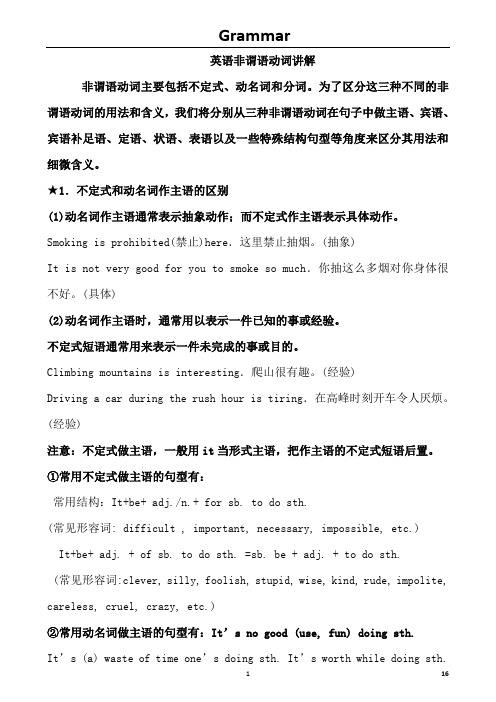不定式与现在分词作宾语补足语的区别
非谓语动词作主语和宾语补足语

非谓语动词作主语和宾语补足语非谓语动词是一种不具备人称和时态的动词形式,包括不定式、现在分词和过去分词。
非谓语动词可以在句中充当主语和宾语补足语,起到补充说明和修饰的作用。
本文将详细介绍非谓语动词作主语和宾语补足语的用法和特点。
一、非谓语动词作主语1. 不定式作主语不定式作主语时,常常位于句首,其后跟随一个动词或介词短语作谓语。
例如:To learn a foreign language requires patience and perseverance.学习一门外语需要耐心和毅力。
2. 现在分词作主语现在分词作主语时,常常强调动作正在进行。
例如:Running in the morning is good for your health.早上跑步对身体健康有好处。
3. 过去分词作主语过去分词作主语时,常常表示被动或已经完成的动作。
例如:Broken glass is dangerous, so be careful.破碎的玻璃很危险,所以要小心。
二、非谓语动词作宾语补足语1. 不定式作宾语补足语不定式作宾语补足语时,常常用于及物动词后,起到对动词的进一步补充和说明的作用。
例如:He wants to go abroad to study.他想去国外留学。
2. 现在分词作宾语补足语现在分词作宾语补足语时,常常表示主动的动作。
例如:I saw him playing basketball in the park.我看见他在公园里打篮球。
3. 过去分词作宾语补足语过去分词作宾语补足语时,常常表示被动或已经完成的动作。
例如:She had her car repaired at the garage.她把她的车送去修理了。
三、注意事项1. 非谓语动词作主语和宾语补足语时,其形式不会受到主语的人称和时态的影响。
例如:Smoking is harmful to your health.吸烟对健康有害。
2. 非谓语动词作主语和宾语补足语时,常常需要使用动词不定式的基本形式或现在分词/过去分词的原形。
2020届全国地区中考英语专项之不定式与现在分词作宾语补足语的用法

2020届全国地区中考英语专项之不定式与现在分词作宾语补足语的用法一、不定式和其短语做宾语补足语不定式和其短语做宾语补足语,要紧强调动作的全过程或一次性的动作。
例如:a. I asked him to come here.b. Did you see anyone come into the room?c. I think him to be a good teacher.d. Please tell her to wait for me at the school gate.能用不定式或不定式短语作宾语补足语动词两种情形,一种是接带to不定式作宾语补足语的动词,一种是接不带to的不定式作宾语补足语的动词。
1.常见的接带to的定式作宾语补足语的动词:tell, ask, want, teach, allow, drive, expect, invite, love, hate, like, prefer, would like等。
其否定形式在不定式前加not。
例如:a. My mother often tells me to study hard at school.b. Mr. Zhang asked us not to play too many computer games at home.c. I want you to teach me how to use a computer.2.常见的接不带to的不定式作宾语补足语的动词要紧是一些表示感受的动词和表示〝使〞、〝让〞的动词,表示情况全过程或一次性动作。
它们要紧有:一感:fell二听:hear, listen to三让:let, make, have四看:see, watch, notice, observe半关心: help help sb. to do / do sth.例如:a. Did you hear me sing a song last night?b. I saw him come into the room yesterday.c. Please let me help you clean / to clean the windows.d. Oh, please don’t make the baby cry again.注意:含不带to的不定式作宾语补足语的句子变成被动语态时,要把to加上,即不可省掉to,例如:a. I heard her sing yesterday. —— She was heard to sing yesterday by me.b. He made me laugh. —— I was made to laugh by him.二、现在分词或现在分词短语作宾语补足语现在分词或现在分词短语作宾语补足语,表示宾语补足语是一个正在进行和发生的动作,具有一定的描述性。
不定式、分词、动名词差别

高中英语:不定式、分词、动名词1. 动名词与不定式的区别动名词起名词作用,在句子中可以作主语、宾语、表语、定语、主语补足语、宾语补足语。
不定式起名词、形容词、副词作用,在句子中除了动名词所起的作用外,还可以作状语。
但两者之间也有差别:(1)不定式的逻辑主语必须与主语一致,而动名词的逻辑主语范围较大,它可以指主语,也可以是泛指。
如:I hate to work on weekends . 我讨厌周末干活。
(指自己干活)。
I hate working on weekends . 我讨厌周末干活。
(可以指自己,也可以泛指)(2)动名词多指抽象的、概念性的动作,可以是多次的、经常的行为,不定式多表示具体的动作,尤其是某一次的动作。
如:Reading in bed is a pleasure .I like swimming but I don’t like to swim in the pool today .我喜欢游泳,但是今天我不喜欢在游泳池里游泳。
Talking for hours at a stretch is more exhausting than you seem to think .一连讲几个小时的话会比你想像的似乎要累。
(泛指讲话)To talk for hours at a stretch is more exhausting than you seem to think .一连讲几个小时的话可比你想像的似乎要累。
(指个人的感受)(3)在某些动词之后只能用动名词,而另一些动词之后只能用不定式。
后接动名词的动词有:admit,avoid,consider,defer,delay,deny,dislike,enjoy,escape,fancy,finish,imagine,include,keep,mind,miss,postpone,practise,recall,recollect,resent,resist,risk,stop,suggest等;短语动词有have done,give up等。
现在分词,不定式,过去分词的区别

辨析:A. ①不定式与动名词作表语一般可以互换使用,在意义上没有多大差别,且其形式差异较大,很容易把握, 如上面例句的①②;②现在分词和动名词同形,在作表语时,学生不易识别。
分辨方法有三:a)分词作表语说明主语的性质特征,回答how的问题;不定式和动名词作表语则说明主语的内容,回答what 或doing what 问题, 如:My job is interesting.(=How is my job?) ; My job is teaching ( to teach ) the students English. (=What is my job?); b)动名词具有名词的句法功能,也能做主语,我们不妨把句中的表语转换成主语,如果句子成立,则是动名词作表语,否则是现在分词作表语。
如:My job is teaching the students English→Teaching the students English is my job.显然句子是成立的,原句中的teaching是动名词;c)分词具有形容词的句法功能,那么,我们可以在作表语的分词前加very(extremely ,fairly ) 等副词,如果句子成立,则动词—ing 形式作表语的是现在分词。
如上面例句:My job is interesting. 可改为:My job is very interesting. 显然句子是成立的,句中的interesting 是现在分词。
B.确定用现在分词还是用过去分词作表语的方法有:现在分词作表语多表示主语所具有的某种特征;过去分词作表语多表示主语所处的状态。
情感动词的v.-ing 形式表示具有某种特征;情感动词的v.-ed形式多表示引起某种情感。
一般地说,事物具有某种特征,而人才具有某种情感,因此,分词作表语的句式可归纳为:a)Sb.﹢be ﹢v-ed ; b)Sth. ﹢be﹢v-ing. 如:a. I am very excited ; b. The news is very exciting.但有一个词例外,那就是missing 。
宾语补足语七种类型英语举例

宾语补足语七种类型英语举例
宾语补足语是英语语法中的一种重要结构,它通常在动词和宾语之间添加一个形容词或副词来进一步描述宾语的状态或行为。
以下是七种常见的宾语补足语类型及其英语举例:
形容词作宾语补足语:
例句:I painted the house blue.(我把房子涂成蓝色。
)
副词作宾语补足语:
例句:He put the book back on the shelf.(他把书放回到书架上。
)介词短语作宾语补足语:
例句:I found the book on the table.(我在桌子上找到了这本书。
)动词不定式作宾语补足语:
例句:She asked me to help her with the task.(她让我帮她完成任务。
)
现在分词作宾语补足语:
例句:They saw the boys playing football.(他们看到男孩们在踢足球。
)
过去分词作宾语补足语:
例句:I heard the door locked.(我听到门被锁上了。
)
名词作宾语补足语:
例句:We elected him president.(我们选他为总统。
)
这些是七种常见的宾语补足语类型,每种都有不同的用法和特点。
理解这些结构可以帮助更好地掌握英语语法。
英语非谓语动词讲解

英语非谓语动词讲解非谓语动词主要包括不定式、动名词和分词。
为了区分这三种不同的非谓语动词的用法和含义,我们将分别从三种非谓语动词在句子中做主语、宾语、宾语补足语、定语、状语、表语以及一些特殊结构句型等角度来区分其用法和细微含义。
★1.不定式和动名词作主语的区别(1)动名词作主语通常表示抽象动作;而不定式作主语表示具体动作。
Smoking is prohibited(禁止)here.这里禁止抽烟。
(抽象)It is not very good for you to smoke so much.你抽这么多烟对你身体很不好。
(具体)(2)动名词作主语时,通常用以表示一件已知的事或经验。
不定式短语通常用来表示一件未完成的事或目的。
Climbing mountains is interesting.爬山很有趣。
(经验)Driving a car during the rush hour is tiring.在高峰时刻开车令人厌烦。
(经验)注意:不定式做主语,一般用it当形式主语,把作主语的不定式短语后置。
①常用不定式做主语的句型有:常用结构:It+be+ adj./n.+ for sb. to do sth.(常见形容词: difficult , important, necessary, impossible, etc.)It+be+ adj. + of sb. to do sth. =sb. be + adj. + to do sth.(常见形容词:clever, silly, foolish, stupid, wise, kind, rude, impolite, careless, cruel, crazy, etc.)②常用动名词做主语的句型有:It’s no good (use, fun) doing sth.It’s (a) waste of time one’s doing sth. It’s worth while doing sth.★2.不定式、动名词和分词作表语的区别(1)不定式作表语1)不定式作表语一般表示具体动作,特别是表示将来的动作。
非谓语动词作定语和宾语补足语总结归纳
非谓语动词作定语和宾语补足语总结归纳非谓语动词是指不具备人称和数的特征,在句中充当其他成分的动词形式。
在英语中,非谓语动词可以用作定语和宾语补足语。
本文将对非谓语动词作定语和宾语补足语的使用进行总结和归纳。
一、非谓语动词作定语1. 作定语的非谓语动词形式:动词的ing形式和过去分词形式。
2. 非谓语动词作定语的位置:通常放在被修饰名词之前,起修饰作用。
3. 非谓语动词作定语的作用:表示被修饰名词的性质、用途、来源、材料、状态等。
4. 非谓语动词作定语的例句:a) The running water in the river is very clear.(河中流动的水非常清澈。
)b) The damaged car has been towed away.(那辆受损的汽车已经被拖走了。
)二、非谓语动词作宾语补足语1. 作宾语补足语的非谓语动词形式:动词的不定式形式和现在分词形式。
2. 非谓语动词作宾语补足语的位置:通常放在及物动词、系动词、感官动词、使役动词等动词后面,起补充说明作用。
3. 非谓语动词作宾语补足语的作用:用来补充说明宾语的性质、特征、目的、结果等。
4. 非谓语动词作宾语补足语的例句:a) She wants to buy a new car.(她想买一辆新车。
)b) I found the children playing happily in the garden.(我发现孩子们在花园里快乐地玩耍。
)综上所述,非谓语动词作为定语和宾语补足语在英语中的应用较为广泛。
了解和掌握非谓语动词的用法对于提高语言表达能力至关重要。
通过灵活运用非谓语动词,可以使语言表达更加准确、生动,增加文章的表现力和吸引力。
因此,在英语学习中,我们要注重对非谓语动词作定语和宾语补足语的学习和应用,提高自己的语言能力。
不定式做宾语状语和宾语补足语的用法-概述说明以及解释
不定式做宾语状语和宾语补足语的用法-概述说明以及解释1.引言1.1 概述概述部分的内容:不定式是英语语法中的一个重要结构,它可以作为宾语状语和宾语补足语出现。
作为宾语状语,不定式能够修饰和说明动作的目的、原因、方式等情况;而作为宾语补足语,不定式则用来补充或者完善宾语的意义。
掌握不定式作为宾语状语和宾语补足语的用法对于我们理解和运用英语具有重要意义。
本文将首先介绍不定式作为宾语状语的用法,包括表示目的、原因和方式的情况。
接着,将详细探讨不定式作为宾语补足语的用法,其中涉及到及物动词和介词后的宾语补足语。
最后,我们将比较不定式作为宾语状语和宾语补足语的区别,以及它们在实际运用中的应用领域和意义。
通过本文的阅读,读者将能够系统地了解和掌握不定式作为宾语状语和宾语补足语的用法。
同时,我们也将展望未来关于不定式的研究方向,并探讨它们在语言学领域中的实际应用价值。
总之,本文将提供一个全面而系统的介绍不定式作为宾语状语和宾语补足语的用法,并对其在实际运用中的意义进行探讨。
希望本文能够为读者提供一定的帮助和指导,同时也为今后相关研究提供一定的借鉴。
1.2 文章结构本文将会以以下几个部分来探讨不定式作为宾语状语和宾语补足语的用法。
2.正文:2.1 不定式作为宾语状语的用法:在这一部分,我们将阐述不定式作为宾语状语的基本用法和常见结构。
我们将探讨不定式作为目的状语、原因状语、结果状语和方式状语的具体用法,并给予例子进行说明。
2.2 不定式作为宾语补足语的用法:这一部分将着重讨论不定式作为宾语补足语时的用法。
我们将讲解不定式作为及物动词的宾语补足语和使役动词的宾语补足语的用法,同时给出一些常见的例子进行解析。
2.3 不定式作为宾语状语和宾语补足语的区别:在这一部分,我们将对不定式作为宾语状语和宾语补足语的区别进行详细比较和分析。
我们将探讨两者的语法特点、用法上的差异,并通过一些实例来解释它们之间的区别和联系。
3.结论:3.1 总结不定式作为宾语状语和宾语补足语的用法:在这一部分,我们将对之前的讨论进行总结,并对不定式作为宾语状语和宾语补足语的用法进行概括性的总结。
高中英语语法――非谓语动词讲解
⾼中英语语法――⾮谓语动词讲解⾼中英语语法――⾮谓语动词⼀、⾮谓语动词的概念动词的基本⽤法是作谓语。
当句中已经有了谓语动词了,要选或要填的动词就只能⽤⾮谓语形式了。
⾮谓语形式有三种:1、动词不定式:to do 2、动词的ing : doing 3、动词的过去分词:done⼆、三种形式的含义(基本⽤法)不定式:表⽰⽬的和将来;动词的ing:表⽰主动和进⾏;过去分词:表⽰被动和完成。
在⾮谓语动词前加not, never. 即not / never to do, not / never doing五、⾮谓语动词的复合结构不定式的复合结构:for / of sb. to do sth.动词ing 形式的复合结构:宾格或所有格+doing (-ing 形式作主语时,⽤的所有格+doing)六、⾮谓语动词的做题步骤1、判定是否⽤⾮谓语形式。
⽅法:看看句⼦中是否已有了谓语动词了2、找⾮谓语动词的逻辑主语。
⽅法:⾮谓语动词的逻辑主语⼀般是句⼦的主语。
3、判断主被动关系。
⽅法:⾮谓语动词与其逻辑主语的主动还是被动关系。
4、判断时间关系。
⽅法:分析句⼦,看看⾮谓语动词所表⽰的动作发⽣在谓语动作之前、之后还是同时。
之前常⽤done; 之后常⽤to do; 同时常⽤doing.学习⾮谓语形式时,建议把三种形式⼀起来⽐较学习,会更加有效⼀些。
⼀、⾮谓语动词作主语和表语的⽐较1、不定式和动名词作主语和表语a. 不定式表⽰⼀次性的、具体的动词。
动词ing 常表⽰⼀般的、泛指的或习惯性的动作。
如:________ is a good form of exercise for both young and old.A. The walkB. WalkingC. To walkD. Walk(分析) a good form 暗⽰泛指⼀般的⾏为,⽤动名词作主语,选 Bb. 不定式作主语时,常⽤it 作形式主语,即⽤句型:It is + adj. / n. + (for / of sb. ) to do sth.It’s important for us to learn English well.It’s kind of you to help us.注意:下⾯⼏个句型是⽤动名词:It’s no good / use doing sth.It’s useless doing sth.There is no need to do sth.2、不定式、动名词、分词作表语的⽐较1、不定式、动名词作表语,.表⽰主语的内容。
不定式,现在分词,过去分词的区别
不定式:一般式,进行式,完成式,被动式,否定形式带to,不带to(被动式应还原to)现在分词:一般式,完成式,被动式,否定形式过去分词一、考查不定式、现在分词与过去分词的基本区别从时间关系上看,不定式表未来,现在分词表进行,过去分词表完成,同时注意不定式和现在分词的完成式也表完成(尤其是表示有明显的先后关系的完成);从主动与被动来看,不定式和现在分词表主动,过去分词表被动,同时注意不定式和现在分词的被动式也表被动(不定式的被动式在表被动的同时还兼表未来,现在分词的被动式表被动的同时还兼表进行)。
如:1. I send you 100 dollars today, the rest _________ in a year. (湖南卷)A. followsB. followedC. to followD. being followed【分析】答案选 C。
动词不定式表示未来的动作。
今天我寄给你100美元,剩下的年内会寄给你。
follow:go after, come after,在....之后,如:What to follow? 接下来吃什么?The dogs followed the fox.这些狗一齐追赶着那狐狸。
The ducklings followed their mother around the pond。
这个句子后半部分,和前半部分之间没有并列连接词and等,所以这不是一个并列句,也就是说,the rest____ in a year.这一部分不是一个句子,而是一个短语形式。
根据意思,the rest是在100 dollars 之后寄去,即the rest follows(go after,be sent)100 dollars ,所以the rest和follow之间应为主动含义。
A follows谓语形式,构成一个一般现在时的句子。
B followed 为一般过去式时,即谓语形式,构成一个句子。
- 1、下载文档前请自行甄别文档内容的完整性,平台不提供额外的编辑、内容补充、找答案等附加服务。
- 2、"仅部分预览"的文档,不可在线预览部分如存在完整性等问题,可反馈申请退款(可完整预览的文档不适用该条件!)。
- 3、如文档侵犯您的权益,请联系客服反馈,我们会尽快为您处理(人工客服工作时间:9:00-18:30)。
不少英语语法书上认为英语中的感官动词如feel, hear, see, look at, listen to, notice, watch等后要跟复合宾语,即"宾语+宾语补足语"并举例说:I heard him speak.我听了他的发言句中的不带to的不定式speak表示已发过言了,表示一个完成的动作I heard him speaking.我听见他在说话句中的现在分词speaking表示"正在说话"笔者认为上述的解释是不正确的下面谈谈自己的一点肤浅见解,与同行们探讨
如果按上述I heard him speak.句中的解释,speak表示"一个完成的动作","讲过话了",在我听的时候,speak怎么会是一个完成的动作呢?按理可推,I heard her singing.能理解为说话的此刻她还在唱歌吗?
由此可见,"一个完成的动作"是对哪个时间参照点而言,如果是对说话的此刻而言,那么,当hear,feel,notice,watch等为过去时,不管是不带to的动词不定式,还是现在分词都表示"完成的动作"
如果hear,feel,notice,see,watch等为一般现在时或一般将来时,则不带to的不定式不可能是"一个完成的动作"如:We want to come and hear you play.能解释为说话的此刻,play是"一个已完成的动作(已演出过了)"吗?
在语言的运用中,实际上不带to的动词不定式表示整个活动(a complete activity, a complete action或a whole action),而现在分词表示正在进行的动作(an activity in progress)或者不管是不是全过程试比较:
I saw him change the wheel of his car.我看见他在换汽车轮子(意味着我看到了整个动作过程)
I saw him changing the wheel of his car.我看见他换汽车轮子(可能意味着我只看到动作过程的一部分)
又如:I saw him cross the road.是指"我看到他穿过马路的整个过程"(从离开人行道到另一侧的人行道),而I saw him crossing the road.则是指"我看到他正在穿越马路"再比较下列动
词不定式和现在分词作宾语补足语在意义上的差别
I watched the boy climb the tree.我看见那男孩爬到树上
I watched the boy climbing the tree.我看见那男孩正在爬树
We felt the table move.我们感到桌子移动了
Can you feel the train slowing again.你能感觉到火车在慢下来吗?
I could hear the girls singing in the classroom.我能听到女孩们在教室里唱歌
另外,笔者有一次听到一位学生向老师质疑下面一个句子:The missing boys were last seen to play near the river.为什么要把句中的to play改为playing?
这位老师对此题作了如下的解析:
"当孩子们走失了,费尽周折最终找到他们时,我们一定会睁大眼睛看着他们在干什么,因此,用playing更逼真,更生动,更贴切"
但笔者认为这位老师误解了句子含义以及playing的用法,因而作了错误的解析虽然他指出了正确的答案,但未完全理解全句句中last应作"上一次"或"最后一次"解全句含义为:The last time they were seen, the missing boys were playing near the river.即丢失的男孩们在丢失之前有人曾看到他们在河边玩耍那么这位老师所说的"最终找到他们","我们一定会睁看大眼睛看着他们在干什么"违背句子原意
应该解析原句不能用to play是因为那就意味着有人从头到尾在看着那些孩子们玩耍,在这种情况下,他们还会丢失吗?而要用playing是对的,就意味着人们并没有观察到男孩们整个玩耍的过程,而只是看到他们玩耍的片段,即没有看到过程的完结又如:
He was seen to cross the road.(整个过程)有人看见他穿过马路
He was seen crossing the road.(正在进行的动作)有人看见他在穿过马路
I was in the kitchen cooking when I felt the floor move.我在厨房做饭,觉得地板动了一下(是指从地震开始到结束的整个地震过程中我都感到了地面的移动)
When I woke up, I felt I could feel the floor moving.当我醒来时,我感觉地板在移动(是指地震开始时,说话人在睡觉或者处于昏迷状态,当他醒来时,突然发现地面的移动)。
